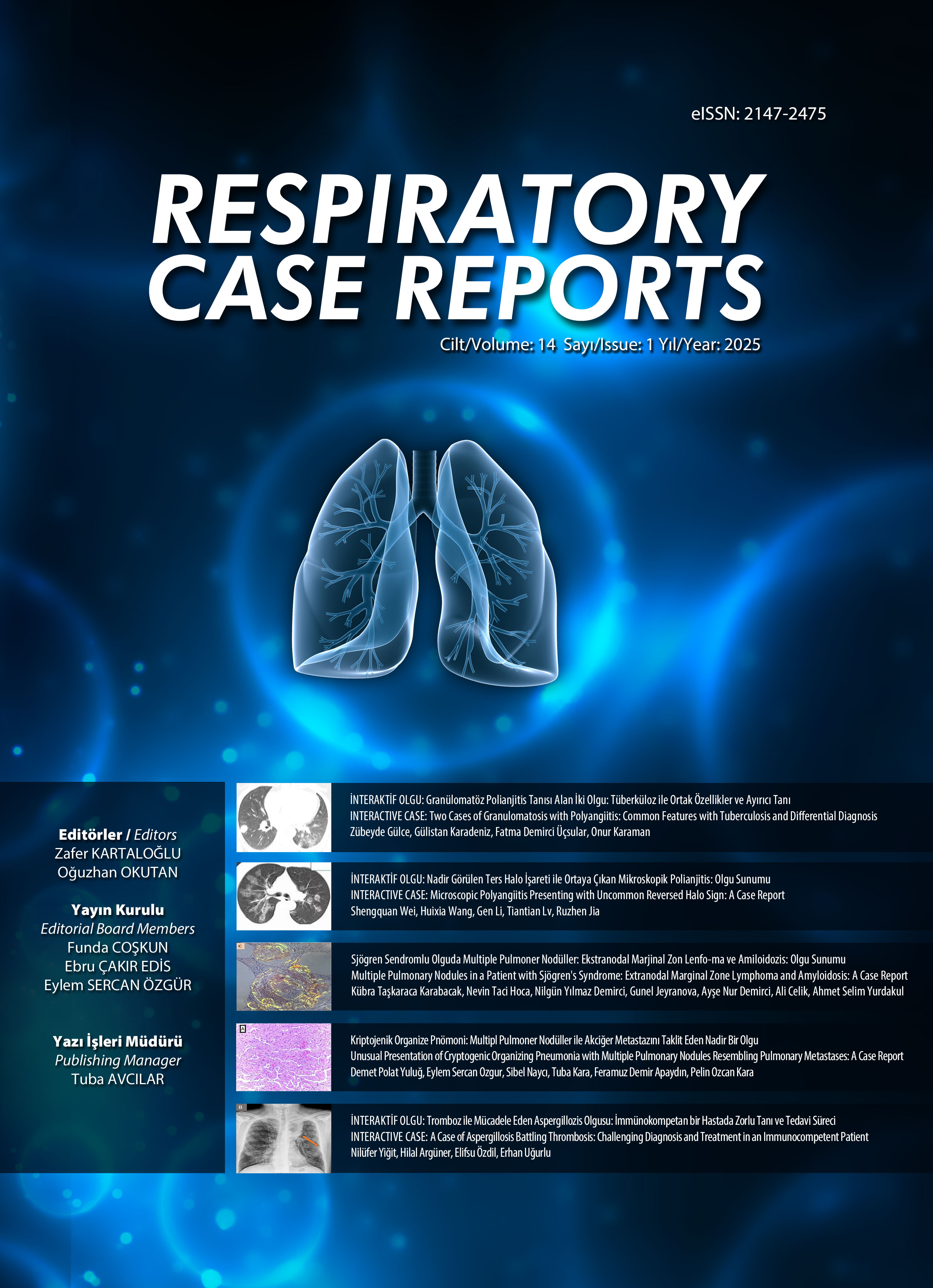e-ISSN 2147-2475

Volume: 5 Issue: 2 - June 2016
| CASE REPORT | |
| 1. | A Rare Complication of Cryotherapy Used in Endobronchial Malignant Melanoma: Cryoshock Ayse Bahadir, Mediha Gonenc Ortakoylu, Isil Kibar, Sinem Iliaz, Mehmet Akif Ozgul, Erdogan Cetinkaya, Naciye Arda doi: 10.5505/respircase.2016.52523 Pages 77 - 80 Endobronchial metastases (EBMs) of malignant melanoma are rare. Cryotherapy is a safe and widely used method for the treatment of EBMs. Herein, we present a malignant melanoma case with EBMs treated with cryotherapy and discuss in the light of the literature data. A 56-year-old male patient was hospitalized for the evaluation of a lung mass. Thoracic computed tomography scan showed a 3x4x7cm necrotic central mass lesion narrowing the left main bronchus. We performed rigid bronchoscopy and applied mechanical resection and cryotherapy. Biopsies revealed malignant melanoma metastases. Three days after the procedure, he was admitted to the hospital with signs of possible cryoshock. To the best of our knowledge, there is no paper reporting cryoshock as a complication of cryotherapy application in lung malignancies in the literature. |
| 2. | Attention to Pheochromocytoma History: Lung Metastasis after Nine Years Fatma Tokgöz Akyıl, Emine Aksoy, Akın Öztürk, Oğuz Aktaş, Tülin Sevim doi: 10.5505/respircase.2016.48303 Pages 81 - 84 A pheochromocytoma is a rare tumor arising from the adrenal medulla chromaffin cells with a malignancy rate of 10%. Metastasis can occur years later, even in the presence of benign histopathological findings. A 55-year-old male was admitted to our clinic with complaints of fever, night sweats, and cough. His physical examination findings were normal. He had hypertension, diabetes mellitus, and coronary artery disease and he never smoked. Radiological examination revealed extended, multiple, well-defined, extended bilateral nodular and mass lesions. Transthoracic needle aspiration lung biopsy was performed and the biopsy result was reported as a pheochromocytoma metastasis. Due to extended lymph node and bone metastasis, he was referred to the oncology department. He died in the second year of the diagnosis. The case is presented due to its rarity with respect to the literature. |
| 3. | INTERACTIVE CASE REPORT: An 81 Year-Old Woman with Hydatid Cyst-Related Pulmonary Embolism Tülay Kıvanç, Hüseyin Lakadamyalı, Hatice Lakadamyalı doi: 10.5505/respircase.2016.62207 Pages 85 - 88 Hydatid cyst related-pulmonary embolism is an uncommon condition. We admitted an 81-year-old woman to our hospital with chest pain. A multi-detector computed tomography of the chest showed an oval, cystic filling defect, containing daughter cysts, causing vessel enlargement within the right main pulmonary artery and its lobar and segmental branches. Three giant hydatid cyst lesions in the right lobe of the liver adjacent to the inferior vena cava with daughter cysts were detected using the abdominal ultrasonography. Hydatid cyst-related pulmonary embolism should be considered in the differential diagnosis in patients who have chest pain and hepatic hydatidosis. |
| 4. | INTERACTIVE CASE REPORT: A Case of Septic Pulmonary Embolism Secondary to Tooth Abscess Muzaffer Sarıaydın, Aydın Balcı, Sevinç Sarınç Ulaşlı, Ersin Günay, Seçil Demir, Mehmet Ünlü doi: 10.5505/respircase.2016.28247 Pages 89 - 92 Septic pulmonary embolism is a disease which spreads of infectious microorganisms embedded in arterial fibrins. It usually causes multiple or bilateral nodular infiltrates and wedge-shaped cavity on bilateral lung parenchyma. A 68-year-old male patient admitted to our clinic with complaints of chest pain and fever. A few cavitary lesions and right-sided pleural effusion were identified on chest X-ray. Thoracic computed tomography revealed bilateral multiple cavitary lesions and pleural effusion in the right hemithorax. Based on his medical history, he received a non-specific antibiotic medi-cation for three days for tooth abscess approximately 20 days ago. Then, treatment was initiated with ceftriaxone and metronidazole. Rapid clinical improvement was observed. With these clinical and radiological findings, the diagnosis of septic pulmonary embolism was made. We present this case to highlight the importance of early diagnosis with detailed medical history and radiological findings of this rare disease with possible serious consequences. |
| 5. | Coinciding of Pulmonary Embolism and Immune Thrombocytopenia; A Rare Case Jülide Çeldir Emre, Tuğba Önalan, Nur Soyer, Sami Deniz, Mustafa Hikmet Özhan doi: 10.5505/respircase.2016.37790 Pages 93 - 96 Immune thrombocytopenia (ITP) is an autoimmune disease which is related to antiplatelet immuno-globulin production, characterized by thrombocytopenia and, mucocutaneous bleeding. A 34-year-old woman had spontaneous abortion three times. Having been detected deep venous thrombosis, thoracic computer tomography (CT) showed a mas-sive pulmonary embolism (PE) involving bilateral pulmonary arteries and segmental branches. The patient with thrombocytopenia (13,000 mm3) was unable to be given low molecular weight heparin (LMWH). The patients peripheral smear and bone marrow aspiration findings were compatible with ITP. Once MTHFR and Factor V mutation for thrombophilia were detected, anticoagulant treat-ment was planned life-long. As the platelet level decreased again, splenectomy was offered by a hematologist. While the patient was hospitalized in general surgery clinic for dyspnea, thoracic CT revealed acute embolism of the bilateral main pulmonary arteries. Our case is discussed due to difficulties in the treatment of recurrent pulmonary embolism and refractory ITP. |
| 6. | INTERACTIVE CASE REPORT: A Case of Foreign Body Aspiration Diagnosed in Early Adulthood Mustafa Çörtük, Elif Tanrıverdi O, Binnaz Zeynep Yıldırım, Kenan Abbaslı, Mehmet Akif Özgül, Erdoğan Çetinkaya doi: 10.5505/respircase.2016.92063 Pages 97 - 99 Foreign body aspiration is usually seen in childhood, mostly under the age of three. Aspiration in adults is rare, except for those with neuropsychiatric disorders and there is almost always a suspicious history for aspiration. Most cases are admitted to hospital early and delayed diagnosis is rare. Herein, we report a 30-year-old male case who was repeatedly treated for pneumonia and dyspnea for the past 20 years. In his recent hospitalization, he was diagnosed and treated as foreign body aspiration. We present this case, as there was no history of aspiration and it was finally diagnosed in the early adulthood. |
| 7. | Should Alpha-1 Antitrypsin Deficiency be Considered in the Etiology of Bronchiectasis? Tülin Sevim, Fatma Tokgöz Akyıl, Emine Aksoy, Umut Kuver, Oğuz Aktaş doi: 10.5505/respircase.2016.30306 Pages 100 - 103 Alpha 1 antitrypsin (AAT) is a glycoprotein of the serine protease family. In deficiency of AAT, pulmonary emphysema is common. Bronchiectasis may accompany with emphysema, although bronchiec-tasis may be rarely isolated. Herein, we report a 55-year-old male, who was examined due to wide-spread cystic bronchiectasis and diagnosed with AAT deficiency. A 55-year-old male was admitted with one week fever, cough, and sputum and was hospitalized due to chronic obstructive pulmonary disease exacerbation with hypoxemic respiratory failure. He was on bronchodilator treatment with a smoking history of 50 pack-year. Chest imaging revealed diffuse cystic bronchiectasis in the middle and lower lung zones. During the etiological inves-tigation, AAT level was found to be 21 mg/dL. He was diagnosed with AAT deficiency. Although most-ly panacinar emphysema is seen in AAT deficiency, bronchiectasis can be rarely predominant finding. It should be considered in all age groups in the dif-ferential diagnosis of bronchiectasis. |
| 8. | Therapeutic Application of Bronchoalveolar Lavage in a Case of Pulmonary Alveolar Proteinosis Hamza Ogun, İpek Özmen, Elif Yıldırım, Korkmaz Oruç, Sinem Ağca Altunbey, Aslıhan Ak, Haluk Celalettin Çalışır doi: 10.5505/respircase.2016.99815 Pages 104 - 107 A 46-year-old male patient was admitted with complaints of cough and dyspnea for three months. The patient received twice anti-tuberculosis therapy within the past eight years. Bilaterally diffuse acinar shadows were observed with a tendency of coalescence on chest X-ray. Diagnostic bronchoscopy and bronchoalveolar lavage were performed for com-mon areas and a crazy-paving pattern of a glass appearance on high-resolution chest computed tomography and white, opaque looking lavage fluid was detected. The bronchoalveolar lavage fluid and radiological findings suggested pulmonary alveolar proteinosis. The bronchoalveolar lavage was performed on the patient with hypoxia. A significant improvement in radiogical findings of chest X-ray in the same day was observed with improved hypoxia. One week later, the therapeutic proce-dure was performed for the other lobe. The patient is still under follow-up. |
| 9. | Sarcoidosis Presenting as Endobronchial Mass: Report of Two Cases Sinem Güngör, Nagihan Durmuş Koçak, Pınar Atagün Güney, Pakize Sucu, Sibel Boğa doi: 10.5505/respircase.2016.86158 Pages 108 - 111 Sarcoidosis is a multi-system disorder with an unknown etiology, mostly affecting the lungs and lymph nodes. Lung involvement is mostly seen as parenchymal disease, while an endobronchial mass lesion is rarely seen. In this study, two cases with bilateral hilar enlargement on X-ray and mediasti-nal lymphadenopathy, bilateral milimetric paren-chymal nodules and atelectasis on thoracic computed tomography were presented, which an endobronchial mass lesion was seen during bronchoscopy. The lesion was diagnosed as sarcoidosis after histopathological examination. Both were followed with no medication. Cases with complete clinical resolution have been reported in the literature. We present these two cases of endobronchial sarcoidosis to highlight, that sarcoidosis should be kept in mind in the differential diagnosis of endobronchial mass lesions. |
| 10. | Drug-Induced Lung Disease: Report of Two Cases İlim Irmak, Dilek Ernam, Ülkü Aka Aktürk, Feyyaz Kabadayı, Hasan Özgen, Makbule Özlem Akbay, Erhan Oğur, Ali Metin Görgüner doi: 10.5505/respircase.2016.32448 Pages 112 - 116 As a considerable number of drugs has the potential of pulmonary toxicity, the diagnosis of drug-induced lung disease is an important challenge. Herein, we present two female cases. The first case was an 80-year-old woman who was under sulfasalazine treatment for ulcerative colitis and the other case was a 70-year-old woman who was under nitrofurantoin treatment due to chronic pyelonephritis. Their physical examination findings were normal and both patients had non-homogenous consolidations with interstitial involvement on computed tomography. Based on the clinical and radiological findings in conjunction with the results of invasive procedures, drug-induced lung disease was suggested. Clinical and radiological improvement was achieved with the discontinuation of the drugs. We report these cases due to its rarity. |
| 11. | Pulmonary Toxicity Due to Low-Dose Amiodarone Usage Fatmanur Çelik Başaran, Canan Doğan, Ayşe Özsöz doi: 10.5505/respircase.2016.92400 Pages 117 - 120 Amiodarone is a group III anti-arrhythmic drug which is used for arrhythmia. The pulmonary toxicity due to amiodarone is the major complication which threats the life. Long-term and high dose usage causes pulmonary toxicity. In this report, we present a case of successfully treated pulmonary toxicity which developed after low-dose amiodarone. |
| 12. | A Case of Recurrent Plasmacytoma with Endobronchial Involvement Hülya Deniz, Özlem Erçen Diken doi: 10.5505/respircase.2016.38358 Pages 121 - 124 Extramedullary plasmacytomas and/or endobronchial plasmacytomas are rare conditions. We present this case due to its rarity. The patient who was diagnosed with extramedullary plasmacytoma of the right vocal cord ten years ago and nasopharynx two years ago was referred to our unit with hemoptysis. A suspicious lesion was detected in the right intermediate bronchus in the thoracic computed tomography (CT) scan and bronchoscopy was performed. A wide-based polypoid lesion in the distal part of the right intermediate bronchus was observed. Examination of the biopsy samples from the endobronchial polypoid lesion showed the presence of plasmacytosis. Extramedullary plasmacytomas are those which involve any soft tissue other than the bone marrow with the upper respiratory tract, being the most frequent site of extramedullary involvement. There are only six cases of endobronchial plasmacytoma in the English literature. |
| 13. | A Case of Herpes Zoster Associated with Thoracic Trauma Murat Türk, Gazi Göktuğ Ceylan, Celal Buğra Sezen doi: 10.5505/respircase.2016.22590 Pages 125 - 127 Herpes Zoster (zona) is an unpredictable disease with sudden onset. Risk factors other than older age and immunosuppression are still not clear. Its frequency may increase early after an injury. Herein, we present a zona case developed after a blunt thoracic injury. |
| 14. | INTERACTIVE CASE REPORT: A Case of Thoracic Empyema due to Streptococcus constellatus Efsun Gonca Uğur Chouseın, Sinem İliaz, Sakine Yılmaz Öztürk, Ayşe Bahadır, Mediha Gönenç Ortaköylü, Belma Akbaba Bağcı, Emel Çağlar doi: 10.5505/respircase.2016.39306 Pages 128 - 131 A 61year-old mentally retarded man with congenital neurological disability presented with cough, wheezing, fever, and agitation for one week. The preliminary diagnosis was bronchopneumonia and respiratory failure and a treatment consisted of empiric antibiotics, bronchodilators, mucolytics and oxygen therapy was initiated. Thoracentesis revealed empyema and a closed tube thoracotomy was placed. Streptococcus constellatus was isolated from the pleural fluid. The patient was not on an oral care. Our microbiology laboratory reported the isolation of Streptococcus constellatus. According to the published literature on the re-sistance to the first-line antibiotics such as beta-lactam inhibitors, macrolides, and metronidazole, antibiotics were changed accordingly. The patient's overall condition improved, the markers of infection normalized, the amount of pleural effusion regressed, and culture of pleural effusion became sterile. After the removal of the thoracic tube, he was discharged from the hospital. Patients with neurological disabilities lacking proper oral hygiene are at high-risk for mortality-bearing diseases such as empyema secondary to non-pathogenic bacteria, including Streptococcus constellatus. Isolating the causative microorganism can guide the antibi-otic therapy where the antibiotic susceptibility testing is not available. |
| 15. | A Case of Sternal Cleft Atalay Şahin, Menduh Oruç, Ahmet Erbey, Fatih Meteroğlu doi: 10.5505/respircase.2016.43255 Pages 132 - 134 Sternal cleft is a rare natal abnormality resulting from complete or partial failure of the sternal bars to fuse. It may occur with abdominal and/or thoracic malformations. Clinical features may vary depending on the associated disorders. Early repair may yield better results. Herein, we present a three-month-old girl with sternal cleft operated. |
| 16. | INTERACTIVE CASE REPORT: Left Subclavian Artery Aneurysm after Gunshot Injury Muharrem Çakmak, Atilla Durkan, Bülent Öztürk, Kerem Toprak, Fırat Ayaz, Mehmet Nail Kandemir doi: 10.5505/respircase.2016.08870 Pages 135 - 138 Aneurysms of the subclavian artery (ASA) are uncommon. The most common etiological factors of ASA are atherosclerosis and Thoracic Outlet Syndrome. A gunshot wound is an extremly rare in etiology. The most common symptoms are chest and shoulder pain. The main complications are rupture, thrombosis, embolism, and peripheral ischemia in the upper extremity. Chest X-ray, arteriography, computed tomography, and angiography are used for the definite diagnosis. Treatment is surgical or endostent application. Here, we present a case with the left ASA after a gunshot injury. |
| 17. | Malignant Mesothelioma Diagnosed with Skin Biopsy Bülent Öztürk, Muharrem Çakmak, Atilla Durkan, Serdar Onat, Refik Ülkü doi: 10.5505/respircase.2016.68725 Pages 139 - 143 Malignant pleural mesothelioma is a malignant tumor of the pleura. Diagnosis is made by pleural biopsy. Malignant mesothelioma cases presenting with clinical findings with skin metastasis with a confirmed diagnosis through skin biopsy are extremely rare. Herein, we present a case diagnosed with mixed mesothelioma with skin biopsy with skin metastasis. |
| 18. | Slow Growing Pulmonary Nodule: Intrapulmonary Solitary Fibrous Tumor Havva Yücel, Nilgün Yılmaz Demirci, Yurdanur Erdoğan, Funda Demirağ, Ülkü Yılmaz, Aydın Yılmaz, Çiğdem Biber doi: 10.5505/respircase.2016.25633 Pages 144 - 148 Solitary fibrous tumors (SFTs) are rare and localized neoplasms of the pleura. They usually grow from the visceral pleura and attached here by a pedincule, growing through the pleural space. The growth of the tumor from visceral pleura through the inside of parenchyma is rare and direct intrapulmonary growth of the tumor without histologically proven connection with the pleura is extremely rare. Most patients are asymptomatic and lesions are seen incidentally in chest radiography. A 52-year-old male patient was followed for 1.5 years for a pulmonary nodule. Transthoracic biopsy was performed due to a further growth in the nodule size and the result was reported as a SFT. Pulmonary wedge resection confirmed the diagnosis of an intrapulmonary SFT. We present this case, as the diagnosis of SFT of a slowly growing peripheral pulmonary nodule was made with transthoracic biopsy preoperatively and confirmed surgically as an intrapulmonary SFT and due to the rarity of intrapulmonary SFTs. |
| LETTER TO EDITOR | |
| 19. | A Rare Cause of Dyspnea: A Giant Vocal Polyp Kerem Kökoğlu, Irfan Kara, Şerife Seçil Karabulut, Sedat Çağlı, İmdat Yüce doi: 10.5505/respircase.2016.53315 Pages 149 - 150 Abstract | |











